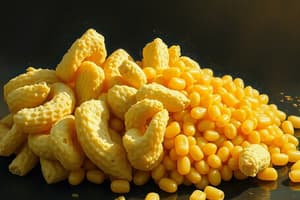Podcast
Questions and Answers
What is the primary function of protein in the diet?
What is the primary function of protein in the diet?
Building and maintaining body tissue.
Proteins are built from simpler organic compounds called?
Proteins are built from simpler organic compounds called?
Amino acids.
Nitrogen is the element that is contained in _______ and not contained in carbohydrates and fats.
Nitrogen is the element that is contained in _______ and not contained in carbohydrates and fats.
Proteins.
What is an indispensable amino acid?
What is an indispensable amino acid?
How many indispensable amino acids are there?
How many indispensable amino acids are there?
What are dispensable amino acids?
What are dispensable amino acids?
What are conditionally indispensable amino acids?
What are conditionally indispensable amino acids?
What is a complete protein?
What is a complete protein?
Which of the following are considered animal proteins with high dietary value?
Which of the following are considered animal proteins with high dietary value?
What is an incomplete protein?
What is an incomplete protein?
In one diet, the greatest proportion of indispensable amino acids are provided by what foods?
In one diet, the greatest proportion of indispensable amino acids are provided by what foods?
What is a negative nitrogen balance?
What is a negative nitrogen balance?
Name some foods that are high in protein.
Name some foods that are high in protein.
What is a lacto-ovo vegetarian?
What is a lacto-ovo vegetarian?
What is a lacto-vegetarian?
What is a lacto-vegetarian?
What is an octo-vegetarian?
What is an octo-vegetarian?
What is a vegan?
What is a vegan?
What are amino acids?
What are amino acids?
What is gelatin?
What is gelatin?
Why are proteins from plant resources such as grains, nuts, and legumes called incomplete proteins?
Why are proteins from plant resources such as grains, nuts, and legumes called incomplete proteins?
What is the primary function of protein?
What is the primary function of protein?
What are complementary proteins?
What are complementary proteins?
What are other functions of protein in the body?
What are other functions of protein in the body?
What are two waste products of protein metabolism?
What are two waste products of protein metabolism?
What is positive nitrogen balance?
What is positive nitrogen balance?
Name examples of conditions where positive nitrogen would be present.
Name examples of conditions where positive nitrogen would be present.
What is the RDA for protein intake for healthy adults?
What is the RDA for protein intake for healthy adults?
What does the state of stability refer to in protein metabolism?
What does the state of stability refer to in protein metabolism?
What is protein balance?
What is protein balance?
What is metabolism?
What is metabolism?
What is anabolism?
What is anabolism?
What is catabolism?
What is catabolism?
What are structural and functional proteins?
What are structural and functional proteins?
Flashcards are hidden until you start studying
Study Notes
Protein Basics
- Proteins primarily function to build and maintain body tissues.
- Composed of simpler organic compounds including carbon, hydrogen, oxygen, and nitrogen.
- Nitrogen is a unique element in proteins, absent in carbohydrates and fats.
Types of Amino Acids
- Indispensable amino acids: cannot be synthesized by the body; must be obtained through diet; there are nine of these.
- Dispensable amino acids: can be synthesized by the body.
- Conditionally indispensable amino acids: typically synthesized but can become essential during illness.
Protein Quality
- Complete proteins contain all nine indispensable amino acids in sufficient amounts for the body's needs.
- Highest dietary value animal proteins include eggs, meat, milk, poultry, cheese, and fish.
- Incomplete proteins lack one or more of the indispensable amino acids, typically found in plant sources.
Dietary Considerations
- Animal products provide the greatest proportion of indispensable amino acids in diets.
- High-protein foods include breast milk, cow's milk, eggs, cheese, meat, soybeans, and soy products.
Vegetarian Protein Sources
- Lacto-ovo vegetarian: includes dairy and plant foods but excludes meat and fish.
- Lacto-vegetarian: consumes only dairy along with grains, legumes, nuts, seeds, fruits, and vegetables.
- Octo-vegetarian: includes eggs in the diet as a source of complete protein.
- Vegan: excludes all animal foods.
Metabolism and Nitrogen Balance
- Negative nitrogen balance: occurs when nitrogen output exceeds intake.
- Positive nitrogen balance: when the body takes in more nitrogen than it expels, present in growth phases and during pregnancy.
- RDA for protein intake for healthy adults is 0.8g/kg per day.
Protein Functionality
- Proteins regulate water balance, digestion, metabolism, cell signaling, transport, and immunity.
- Metabolic waste products of protein include urea and ammonia.
- Protein metabolism involves two processes:
- Anabolism: synthesizes amino acids into tissue proteins.
- Catabolism: breaks down proteins into amino acids.
- The state of dynamic equilibrium occurs when protein breakdown equals synthesis, known as protein balance.
Structural and Functional Proteins
- Proteins can be reassembled into various forms once broken down into amino acids, highlighting their versatile roles in biological functions.
Studying That Suits You
Use AI to generate personalized quizzes and flashcards to suit your learning preferences.




